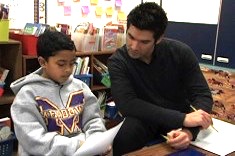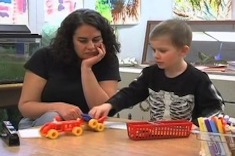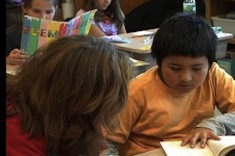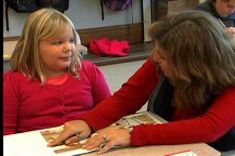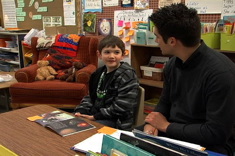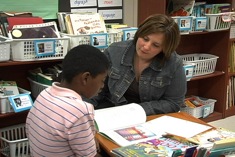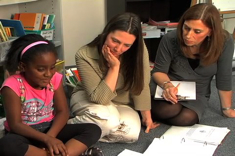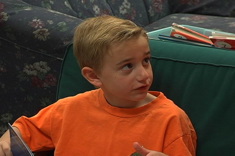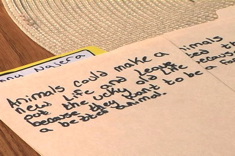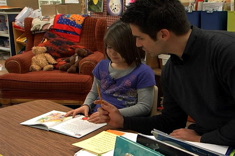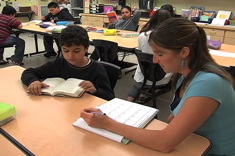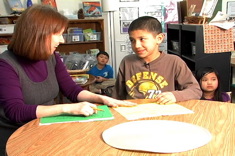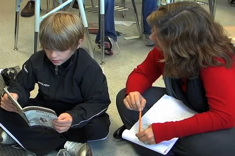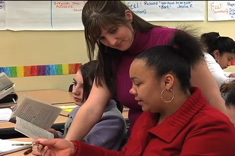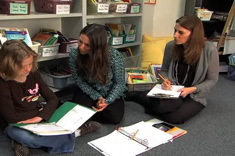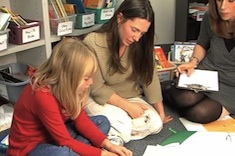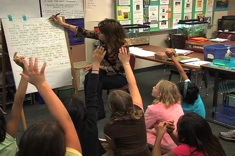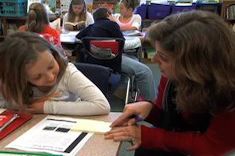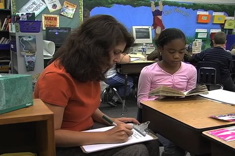Conferring
The teachable moment is what we live for - is there anything more magic than reaching a reader or writer with exactly the right words at exactly the right time? We've bottled some of that magic in the resources that follow, with print guidelines and scores of video examples from master teachers.
Latest Content
The Blank Page and Better Teaching
Aimee Buckner learns some important lessons about how images and words work together for student writers when she moves between second- and fifth-grade classrooms.
Conferring to Coteaching
In this first video in a two-part series, Sean Moore confers with second grader Isaiah. Sean prepares Isaiah to share what he is learning later in the writing workshop.
Revising My Recording Form for Writing Conferences
Mandy Robek shares how she has revised the records she keeps during writing conferences.
More Conferring and Fewer Groups in Kindergarten
Mandy Robek finds she needs fewer reading groups and more conferring with the emergent readers in her kindergarten class. She shares how she structures her brief time with students and a conferring form.
From Playing to Drawing to Writing in Preschool
Kelly Petrin guides Drew from playing to drawing and finally writing during this conference in her preschool classroom.
Never Say Never: Motivation to Read from an Unlikely Source
Knock knock. Who’s there? A boy who loves sports and has no motivation for reading. Barclay Marcell discovers an unlikely source of engaging text for a child who just doesn’t enjoy books.
Conferring for Engagement: First Steps
Aimee Buckner confers with a fourth grader who is learning how to choose books for independent reading. In this video, she gives advice in the first conference and then returns 10 minutes later for a follow-up meeting.
Conferring About Tracking Characters
In this video from a 4th grade classroom, Aimee Buckner confers with a student who is reading The Other Side by Jacqueline Woodson.
From Rages to Rags: Conferring with Conner
When to let a child guess, and when to give the correct answer in a reading conference? That's the struggle for 2nd grade teacher Sean Moore as he confers with Conner.
Rereading Strategy: Conferring with Emily
Sean Moore confers with 2nd grader Emily about the strategy of rereading for comprehending reading and writing.
Middle School Conferring About a Series
In this video from Katie Doherty’s sixth-grade classroom, Katie confers with a student who has returned to a series book she had previously rejected. Katie weaves in talk about strategies, particularly inferring (a focus of whole-class minilessons).
Accuracy and Comprehension: Conferring in Second Grade
In this video from Sean Moore’s second-grade classroom, Sean confers with a student who comprehends text well but has some issues with accuracy.
Conferring with Vita: Working Through Silence
Andie Cunningham confers with Vita, an English language learner whose first language is Russian. Vita is in the silent period. Notice how Andie coaxes communication from Vita, and manages to convey a sense of delight at her work, an acknowledgment of Vita’s importance in the classroom community, and some guidance for future writing.
Listen In: Writing Reviews
Heather Rader uses Kincaid’s intricate system for analyzing books to build a writing agenda in this writing conference.
Next-Read Stack: Conferring for Independence
Franki Sibberson explains the value of "Next-Read Stack" conferences for fostering independence, and includes a video example.
Listen In: Maya is a Chapter Writer
Some young writers take a lot of time and encouragement on the journey to uninhibited prose, while others zip to prolific. Maya is such a writer. Heather Rader assists this proficient 2nd grade writer as her teacher observes.
Fluency in Focus: Conferring with Jake
Gail Boushey confers with Jake, a seven-year-old who is setting a reading goal of developing fluency. After the conference, she debriefs with Joan Moser.
Conferring About Thesis Statements
In this conference with a 4th grader, Beth Lawson talks about supporting details for thesis statements. This is part of the video series from Beth’s room on essay writing.
Conferring About Chunking Words in Second Grade
Sean Moore confers with a 2nd grader who is learning the strategy of chunking words in reading. Notice how Sean focuses the student, refers to previous conferences, and previews an upcoming whole-class reading.
Conferring with Tweens: Boys and Series Books
In this conference from a 6th grade classroom, Katie Doherty confers with a boy who is reading a book from a series she is unfamiliar with – watch how she engages the child to learn about the series and refocus the discussion on skills and goals.
Stuck on a Thesis: Conferring
In this conference with a 4th grader, Beth Lawson works with a student who has chosen a challenging essay topic and is struggling to develop his thesis.
Stop and Track: Conferring with a Fifth-Grade Reader
In this conference with a 5th grader, Aimee Buckner shares two strategies — one to use when putting a book away between readings, and another to help keep track of characters in a complex narrative where the point of view is constantly shifting.
“And Then and Then and Then”: Moving Students from Retelling to Thoughtful Response
Katie Doherty confers with sixth grader Kristina during reading workshop. Kristina is new to the classroom, and Katie demonstrates how to gently move a student from retelling to more thoughtful responses to literature with a few simple and carefully worded questions.
Listen In: Knowing When You’re Done
When is writing finished? Heather Rader confers with a second grader over that age-old question for writers as Linda Karamatic listens in.
Listen In: XBox Game Writing
Boys and their toys: Heather Rader confers with a second grader over his game writing while Linda Karamatic listens in.
Listen In: Magnifying a Moment in Writing
Sometimes using a prop can help young students understand a revision strategy. Heather Rader helps second-grader Sammi understand how to “magnify” a moment when revising her writing.
Scaring Up Better Narratives Part 3
Aimee Buckner leads a lesson on brainstorming topics in writer's notebooks using the mentor text Some Things Are Scary. In this final installment of a three-part series, Aimee continues to confer with students and shares a great tip for nonfiction research.
Frogs as Learning Ambassadors Part 2: Literary Nonfiction in 4th Grade
Andrea Smith explains how the classroom environment influences instruction in the second installment of this video series.
Main Ideas, Summaries, and Notes in a Reading Conference
In this conference with a fourth grader, Aimee Buckner tackles text choice, notes, and main ideas all in less than five minutes. You’ll notice teachers observing in the background; the conference is part of a demonstration lesson sequence.
Conferring About Rereading Strategies
In this conference with a fourth grader, Aimee Buckner guides a child to think more deeply and critically about a book being read to the whole class, Goblins in the Castle.
Browse Content By
Type
Category
- Assessment Tools
- Big Fresh Archives
- Booklists
- Choice Numeracy
- Classroom Design
- Common Core
- Community Building
- Conferring
- Content Literacy
- Digital Literacy
- English Language Learners
- Equity
- Family Relations
- Free Samples
- Guiding Groups
- Leadership
- Literacy Coaches
- Mentor Texts
- Minilessons
- New Teacher Mentors
- Podcasts
- Poetry
- Quote Collections
- Reading Strategies
- Self Care
- Struggling and Striving Learners
- Talking and Listening
- Teacher Study Groups
- Teaching Reading
- Teaching Writing
- Word Study and Vocabulary
Author
- Melissa Quimby
- Nawal Qarooni
- Gwen Blumberg
- Julie Cox
- The Lead Learners
- Hannah Tills
- Josie Stewart
- Ruth Metcalfe
- Mallory Messenger
- Becca Burk
- Jodie Bailey
- Vivian Chen
- Mary Brower
- Tiffany Abbott Fuller
- Stephanie Affinito
- Ruth Ayres
- Leigh Anne Eck
- Heather Fisher
- Shari Frost
- Julie Johnson
- Suzy Kaback
- Gigi McAllister
- Shirl McPhillips
- Melanie Meehan
- Cathy Mere
- Debbie Miller
- Tara Barnett and Kate Mills
- Tammy Mulligan
- Dana Murphy
- Bitsy Parks
- David Pittman
- Brenda Power
- Heather Rader
- Matt Renwick
- Mandy Robek
- Christy Rush-Levine
- Gretchen Schroeder
- Jen Schwanke
- Brian Sepe
- Katherine Sokolowski
- Stella Villalba
- Jennifer Vincent
Grade Level
Choice Literacy Membership
Articles
Get full access to all Choice Literacy article content
Videos
Get full access to all Choice Literacy video content
Courses
Access Choice Literacy course curriculum and training


